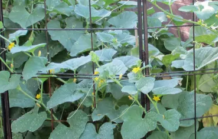Having never really been “into” growing “greens”. I decided to try harder this year! This is my first year growing swiss chard. I must say I think I have found a “new” veggie for me! Besides tasting good chard packs a huge amount of vitamin A and it is naturally high in sodium. One cup contains 313 mg of sodium, which is very high for vegetables.
Chard is also surprisingly high in other minerals as well, i.e., calcium, iron, magnesium, phosphorus and potassium. Besides swiss chard another vegetable is beets. Beets are a popular vegetable and can be grown as a spring or fall crop in Kansas. Tops can be used as a cooked green rich in vitamin A, and the roots are a good source of vitamin C. Roots may be canned or pickled and are served diced, sliced, whole, and in strips. Beet juice is the basic ingredient of borscht. Swiss chard is a close relative of the beet and produces foliage rather than an enlarged root. Nutritional value and uses are similar to those for beets.
Varieties – Red round varieties include Detroit Dark Red, Early Wonder, Crosby, Ruby Ball, Little Ball, and Ruby Queen. Elongated varieties include Cylindria and Long Red Blood.
Varieties of Swiss chard include red-stalked varieties such as Burgandy and Ruby, or white-stalked varieties such as Fordhook, Lucullus, and Perpetual.
When to plant – Beets and chard are fairly frost hardy and can be planted in early to mid-April in many areas of Kansas. Irrigate carefully to avoid soil crusting, which prevents good germination. Plant fall beets or chard in early August.
Spacing – The beet “seed” is actually a cluster of seeds in a dried fruit (one variety–Monogem–has a single seed per cluster). Plant the seeds about an inch apart and about ½ inch deep. Hand thinning is usually necessary to provide a uniform stand of beets properly spaced 2-3 inches apart. Poorly thinned stands will have an abundance of tops with few or small roots.
Care – Beets and chard compete poorly with weeds, so, frequent shallow cultivations are necessary. Beet plants require a fertile well-watered location. Hand thin the plants when they are 1-2 inches tall to avoid damage to surrounding plants.
Harvest – Select beets of the diameter you prefer. Roots larger than 2-2½ inches in diameter are often tough and woody. Beets for baby beets or whole canning should be harvested smaller. Trim the tops of beets or chard to ½-1 inch above the roots and store in plastic bags in a refrigerator before use. Mulch fall- planted beets to prolong the fresh harvest season, but use them before they freeze.
Cut the outer leaves of chard when they are young and tender or about 8-10 inches long.
The inner leaves will continue to grow for additional harvests until hot weather (for spring crop) or a severe freeze (for fall crop) stops the plant growth.




